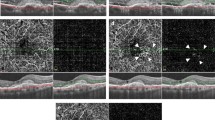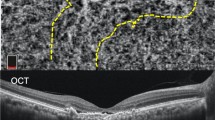Abstract
Purpose
To study serial changes in branching neovascular networks (BNN) by using optical coherence tomography angiography (OCTA) in patients with polypoidal choroidal vasculopathy (PCV) who underwent combined photodynamic therapy (PDT) and anti-vascular endothelial growth factor (anti-VEGF) therapy.
Methods
In this retrospective study of 30 PCV patients who underwent combined therapy, OCTA images obtained at baseline and 1, 3, and 6 months after treatment were collected. The vessel area, vessel percentage area, average vessel length, and presence of polypoidal lesions on OCTA images as well as best-corrected visual acuity (BCVA), central retinal thickness (CRT), and central choroidal thickness (CCT) were recorded at each time point.
Results
The BNN- and polypoidal lesion-detection rates on baseline OCTA images were 100% and 71%, respectively. The vessel area decreased during the first 3 months, and increased 6 months post-treatment, showing significant differences from baseline (p = 0.031). The vessel percentage area also reduced 1 and 3 months post-treatment (p = 0.025) and increased 6 months post-treatment. Continuous polypoidal lesion regression was observed from 1 to 3 and 6 months post-treatment (p = 0.031, p = 0.004, p = 0.002, respectively, in comparison with baseline). Patients with a decreasing vessel area over 6 months showed greater choroidal thickness than those with increasing vessel area (p = 0.004).
Conclusions
The BNN showed initial regression but were enlarged at 6 months after therapy. Patients showing continuous BNN regression showed a thicker choroid at baseline. This difference should be considered during treatment for PCV, and OCTA could be used for follow-up evaluations of PCV patients.





Similar content being viewed by others
Code Availability
Not applicable.
References
Imamura Y, Engelbert M, Iida T, Freund KB, Yannuzzi LA (2010) Polypoidal choroidal vasculopathy: a review. Surv Ophthalmol 55:501–515. https://doi.org/10.1016/j.survophthal.2010.03.004
Cheung CMG, Lai TYY, Teo K, Ruamviboonsuk P, Chen SJ, Kim JE, Gomi F, Koh AH, Kokame G, Jordan-Yu JM, Corvi F, Invernizzi A, Ogura Y, Tan C, Mitchell P, Gupta V, Chhablani J, Chakravarthy U, Sadda SR, Wong TY, Staurenghi G, Lee WK (2021) Polypoidal choroidal vasculopathy: consensus nomenclature and non-indocyanine green angiograph diagnostic criteria from the Asia-Pacific Ocular Imaging Society PCV Workgroup. Ophthalmology 128:443–452. https://doi.org/10.1016/j.ophtha.2020.08.006
Palkar A, Khetan V (2019) Polypoidal choroidal vasculopathy:an update on current management and review of literature. Taiwan Journal of Ophthalmology 9:72–92. https://doi.org/10.4103/tjo.tjo_35_18
Spaide RF, Yannuzzi LA, Slakter JS, Sorenson J, Orlach DA (1995) Indocyanine green videoangiography of idiopathic polypoidal choroidal vasculopathy. Retina 15:100–110. https://doi.org/10.1097/00006982-199515020-00003
Chen LJ, Cheng CK, Yeung L, Yang CH, Chen SJ (2020) Management of polypoidal choroidal vasculopathy: experts consensus in Taiwan. J Formos Med Assoc 119:569–576. https://doi.org/10.1016/j.jfma.2019.04.012
Koh A, Lai TYY, Takahashi K, Wong TY, Chen LJ, Ruamviboonsuk P, Tan CS, Feller C, Margaron P, Lim TH, Lee WK (2017) Efficacy and safety of ranibizumab with or without verteporfin photodynamic therapy for polypoidal choroidal vasculopathy: a randomized clinical trial. JAMA Ophthalmol 135:1206–1213. https://doi.org/10.1001/jamaophthalmol.2017.4030
Lee WK, Iida T, Ogura Y, Chen SJ, Wong TY, Mitchell P, Cheung GCM, Zhang Z, Leal S, Ishibashi T (2018) Efficacy and safety of intravitreal aflibercept for polypoidal choroidal vasculopathy in the PLANET study: a randomized clinical trial. JAMA Ophthalmol 136:786–793. https://doi.org/10.1001/jamaophthalmol.2018.1804
Spaide RF, Klancnik JM Jr, Cooney MJ (2015) Retinal vascular layers imaged by fluorescein angiography and optical coherence tomography angiography. JAMA Ophthalmol 133:45–50. https://doi.org/10.1001/jamaophthalmol.2014.3616
Alasil T, Ferrara D, Adhi M, Brewer E, Kraus MF, Baumal CR, Hornegger J, Fujimoto JG, Witkin AJ, Reichel E, Duker JS, Waheed NK (2015) En face imaging of the choroid in polypoidal choroidal vasculopathy using swept-source optical coherence tomography. Am J Ophthalmol 159:634–643. https://doi.org/10.1016/j.ajo.2014.12.012
Chi YT, Yang CH, Cheng CK (2017) Optical coherence tomography angiography for assessment of the 3-dimensional structures of polypoidal choroidal vasculopathy. JAMA Ophthalmol 135:1310–1316. https://doi.org/10.1001/jamaophthalmol.2017.4360
Su Z, Ye P, Teng Y, Zhang L, Shu X (2012) Adverse reaction in patients with drug allergy history after simultaneous intravenous fundus fluorescein angiography and indocyanine green angiography. J Ocul Pharmacol Ther 28:410–413. https://doi.org/10.1089/jop.2011.0221
Huang CH, Yeh PT, Hsieh YT, Ho TC, Yang CM, Yang CH (2019) Characterizing branching vascular network morphology in polypoidal choroidal vasculopathy by optical coherence tomography angiography. Sci Rep 9:595. https://doi.org/10.1038/s41598-018-37384-y
Sayanagi K, Hara C, Fukushima Y, Sato S, Sakaguchi H, Nishida K (2019) Time course of swept-source optical coherence tomography angiography findings after photodynamic therapy and aflibercept in eyes with age-related macular degeneration. Am J Ophthalmol Case Rep 15:100485–100485. https://doi.org/10.1016/j.ajoc.2019.100485
Miere A, Butori P, Cohen SY, Semoun O, Capuano V, Jung C, Souied EH (2019) Vascular remodeling of choroidal neovascularization after anti–vascular endothelial growth factor therapy visualized on optical coherence tomography angiography. Retina 39:548–557. https://doi.org/10.1097/iae.0000000000001964
Asano-Shimizu K, Asano S, Murata H, Azuma K, Nomura Y, Inoue T, Ogawa A, Asaoka R, Obata R (2020) Early changes of vascular lesions and responses to combined photodynamic therapy in patients with polypoidal choroidal vasculopathy. Int Ophthalmol. https://doi.org/10.1007/s10792-020-01299-3
Shen YS, Cheng CK (2020) Using optical coherence tomography angiography in assessment of the anti-vascular endothelial growth factor effect for pathological vascular tissue in age-related macular degeneration and polypoidal choroidal vasculopathy. Eur J Ophthalmol: 1120672120913012. https://doi.org/10.1177/1120672120913012
Hsia Y, Chan LW, Yang CH, Yang CM, Hsieh YT (2019) Prognostic factors for combined ranibizumab and prompt verteporfin photodynamic therapy for polypoidal choroidal vasculopathy. Photodiagnosis Photodyn Ther 27:227–233. https://doi.org/10.1016/j.pdpdt.2019.06.004
Zudaire E, Gambardella L, Kurcz C, Vermeren S (2011) A computational tool for quantitative analysis of vascular networks. PLoS ONE 6:e27385. https://doi.org/10.1371/journal.pone.0027385
von der Emde L, Thiele S, Pfau M, Nadal J, Meyer J, Möller PT, Schmid M, Fleckenstein M, Holz FG, Schmitz-Valckenberg S (2020) Assessment of exudative activity of choroidal neovascularization in age-related macular degeneration by OCT angiography. Ophthalmologica 243:120–128. https://doi.org/10.1159/000503609
Roberts PK, Nesper PL, Gill MK, Fawzi AA (2017) Semiautomated quantitative approach to characterize treatment response in neovascular age-related macular degeneration: a real-world study. Retina 37:1492–1498. https://doi.org/10.1097/iae.0000000000001400
Bo Q, Yan Q, Shen M, Song M, Sun M, Yu Y, Rosenfeld PJ, Wang F, Sun X (2019) Appearance of polypoidal lesions in patients with polypoidal choroidal vasculopathy using swept-source optical coherence tomographic angiography. JAMA Ophthalmol 137:642–650. https://doi.org/10.1001/jamaophthalmol.2019.0449
Wang M, Zhou Y, Gao SS, Liu W, Huang Y, Huang D, Jia Y (2016) Evaluating polypoidal choroidal vasculopathy with optical coherence tomography angiography. Invest Ophthalmol Vis Sci 57:526–532. https://doi.org/10.1167/iovs.15-18955
Tomiyasu T, Nozaki M, Yoshida M, Ogura Y (2016) Characteristics of polypoidal choroidal vasculopathy evaluated by optical coherence tomography angiography. Investigative Ophthalmology & Visual Science 57:324–330. https://doi.org/10.1167/iovs.15-18898
Nowak-Sliwinska P, van den Bergh H, Sickenberg M, Koh AH (2013) Photodynamic therapy for polypoidal choroidal vasculopathy. Prog Retin Eye Res 37:182–199. https://doi.org/10.1016/j.preteyeres.2013.09.003
Koh A, Lee WK, Chen LJ, Chen SJ, Hashad Y, Kim H, Lai TY, Pilz S, Ruamviboonsuk P, Tokaji E, Weisberger A, Lim TH (2012) EVEREST study: efficacy and safety of verteporfin photodynamic therapy in combination with ranibizumab or alone versus ranibizumab monotherapy in patients with symptomatic macular polypoidal choroidal vasculopathy. Retina 32:1453–1464. https://doi.org/10.1097/IAE.0b013e31824f91e8
Koh A, Lai TYY, Takahashi K, Wong TY, Chen L-J, Ruamviboonsuk P, Tan CS, Feller C, Margaron P, Lim TH, Lee WK, group EIs (2017) Efficacy and safety of ranibizumab with or without verteporfin photodynamic therapy for polypoidal choroidal vasculopathy: a randomized clinical trial. JAMA ophthalmology 135: 1206-1213. https://doi.org/10.1001/jamaophthalmol.2017.4030
Lee WK, Kim KS, Kim W, Lee SB, Jeon S (2012) Responses to photodynamic therapy in patients with polypoidal choroidal vasculopathy consisting of polyps resembling grape clusters. Am J Ophthalmol 154:355-365.e351. https://doi.org/10.1016/j.ajo.2012.02.019
Teo KYC, Yanagi Y, Lee SY, Yeo IYS, Tan GSW, Mathur R, Chan CM, Wong TY, Cheung CMG (2018) Comparison of optical coherence tomography angiographic changes after anti-vascular endothelial growth factor therapy alone or in combination with photodynamic therapy in polypoidal choroidal vasculopathy. Retina 38:1675–1687. https://doi.org/10.1097/iae.0000000000001776
Asano-Shimizu K, Asano S, Murata H, Azuma K, Nomura Y, Inoue T, Ogawa A, Asaoka R, Obata R (2020) Early changes of vascular lesions and responses to combined photodynamic therapy in patients with polypoidal choroidal vasculopathy. Int Ophthalmol 40:1335–1345. https://doi.org/10.1007/s10792-020-01299-3
Lee WK, Lee PY, Lee SK (2008) Photodynamic therapy for polypoidal choroidal vasculopathy: vaso-occlusive effect on the branching vascular network and origin of recurrence. Jpn J Ophthalmol 52:108–115. https://doi.org/10.1007/s10384-007-0501-y
Akaza E, Mori R, Yuzawa M (2008) Long-term results of photodynamic therapy of polypoidal choroidal vasculopathy. Retina 28:717–722. https://doi.org/10.1097/IAE.0b013e31816577cb
Hagag AM, Gao SS, Jia Y, Huang D (2017) Optical coherence tomography angiography: technical principles and clinical applications in ophthalmology. Taiwan journal of ophthalmology 7:115–129. https://doi.org/10.4103/tjo.tjo_31_17
Iesato Y, Tanaka M, Murata M, Kitahara J, Hirano T, Kurenuma T, Yoshida N, Murata T (2018) Complete regression of branching vascular network in polypoidal choroidal vasculopathy by ranibizumab and photodynamic therapy, two case reports. BMC Ophthalmol 18:284. https://doi.org/10.1186/s12886-018-0952-6
Chen Y, Yang Z, Xia F, Ning H, Hua R (2018) The blood flow characteristics of polypoidal choroidal vasculopathy and the choroidal remodelling process after photodynamic therapy. Lasers Surg Med 50:427–432. https://doi.org/10.1002/lsm.22801
Shen YS, Cheng CK (2021) Using optical coherence tomography angiography in assessment of the anti-vascular endothelial growth factor effect for pathological vascular tissue in age-related macular degeneration and polypoidal choroidal vasculopathy. Eur J Ophthalmol 31:1267–1280. https://doi.org/10.1177/1120672120913012
Hata M, Tagawa M, Oishi A, Kawashima Y, Nakata I, Akagi-Kurashige Y, Yamashiro K, Ooto S, Tamura H, Miyata M, Miyake M, Ueda-Arakawa N, Takahashi A, Tsujikawa A (2019) Efficacy of photodynamic therapy for polypoidal choroidal vasculopathy associated with and without pachychoroid phenotypes. Ophthalmol Retina 3:1016–1025. https://doi.org/10.1016/j.oret.2019.06.013
Sasahara M, Tsujikawa A, Musashi K, Gotoh N, Otani A, Mandai M, Yoshimura N (2006) Polypoidal choroidal vasculopathy with choroidal vascular hyperpermeability. Am J Ophthalmol 142:601–607. https://doi.org/10.1016/j.ajo.2006.05.051
Jirarattanasopa P, Ooto S, Nakata I, Tsujikawa A, Yamashiro K, Oishi A, Yoshimura N (2012) Choroidal thickness, vascular hyperpermeability, and complement factor H in age-related macular degeneration and polypoidal choroidal vasculopathy. Invest Ophthalmol Vis Sci 53:3663–3672. https://doi.org/10.1167/iovs.12-9619
Chan WM, Lam DS, Lai TY, Liu DT, Li KK, Yao Y, Wong TH (2004) Photodynamic therapy with verteporfin for symptomatic polypoidal choroidal vasculopathy: one-year results of a prospective case series. Ophthalmology 111:1576–1584. https://doi.org/10.1016/j.ophtha.2003.12.056
Koizumi H, Yamagishi T, Yamazaki T, Kinoshita S (2013) Relationship between clinical characteristics of polypoidal choroidal vasculopathy and choroidal vascular hyperpermeability. Am J Ophthalmol 155:305-313.e301. https://doi.org/10.1016/j.ajo.2012.07.018
Azuma K, Okubo A, Nomura Y, Zhou H, Terao R, Hashimoto Y, Asano KS, Azuma K, Inoue T, Obata R (2020) Association between pachychoroid and long-term treatment outcomes of photodynamic therapy with intravitreal ranibizumab for polypoidal choroidal vasculopathy. Sci Rep 10:8337. https://doi.org/10.1038/s41598-020-65346-w
Akaza E, Mori R, Yuzawa M (2008) Long-term results of photodynamic therapy of polypoidal choroidal vasculopathy. Retina 28:717–722. https://doi.org/10.1097/IAE.0b013e31816577cb
Author information
Authors and Affiliations
Contributions
Study conception and design—WWY, CHY, and TTL; data collection—WWY, CHY, TCC, YTH, TCH, CMY, FYU, TTL; analysis and interpretation of data—WWY, CHY, and TTL; drafting of the article—WWY and TTL; critical revision of the article—CHY, CMY, TTL; final approval of the article—WWY, CHY, TCC, YTH, TCH, CMY, FYL, TTL; overall responsibility—TTL.
Corresponding author
Ethics declarations
Ethics approval and consent to participate
This retrospective review was conducted with approval from the National Taiwan University Hospital Institutional Review Board and in accordance with the tenets of the Declaration of Helsinki.
Consent for publication
Not applicable.
Conflict of interest
The authors declare no competing interests.
Additional information
Publisher's note
Springer Nature remains neutral with regard to jurisdictional claims in published maps and institutional affiliations.
Rights and permissions
About this article
Cite this article
Wang, WY., Yang, CH., Chen, TC. et al. Quantitative analysis of branching neovascular networks in polypoidal choroidal vasculopathy by optical coherence tomography angiography after photodynamic therapy and anti-vascular endothelial growth factor combination therapy. Graefes Arch Clin Exp Ophthalmol 260, 2249–2260 (2022). https://doi.org/10.1007/s00417-022-05583-z
Received:
Revised:
Accepted:
Published:
Issue Date:
DOI: https://doi.org/10.1007/s00417-022-05583-z




